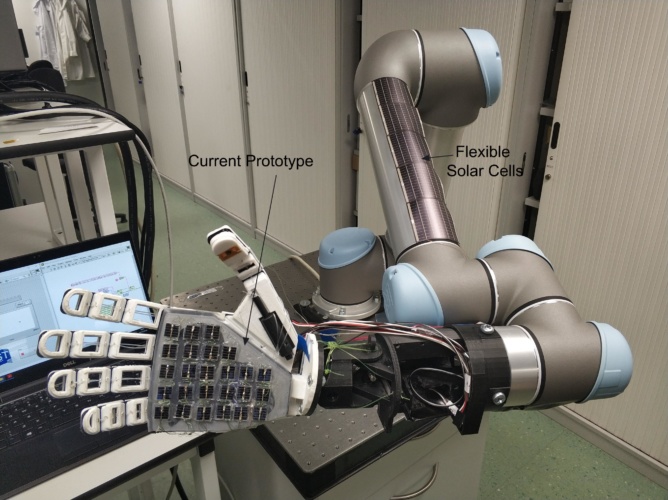
Described in IEEE Transactions on Robotics, the technology uses the miniaturised solar cells not only to power the actuators in a robotic hand, but also to give it a sense of ‘touch’ by measuring variations in cell output as objects approach and diminish the available light. By gauging the levels of power produced in each cell, the e-skin can detect the shape of an incoming object.
Glasgow University team develops “stopgap” COVID-19 ventilator
Graphene-based wearable supercapacitor powers prosthetic hand
In addition, simple LEDs in between the solar cells bounce infra-red light off approaching objects to assess distance. Combined, the two forms of light measurement provide the skin with a sense of touch that could enhance prosthetic limbs and robotics, without the need for embedded touch sensors. During testing in the lab, it enabled the team’s robotic hand to grasp objects such as rubber balls that were placed in front of it.
“Touch-sensitive electronic skin has found numerous experimental applications in prosthetics and robotics in recent years, but our project is the first energy-generating e-skin capable of offering touch feedback without using dedicated touch sensors,” said Professor Ravinder Dahiya, who leads the Bendable Electronics and Sensing Technologies (BEST) Group at Glasgow’s James Watt School of Engineering.
“That lack of sensors means the skin requires no conventional power source to work, unlike other equivalent devices which include touch sensors. In fact, the skin itself is the source of energy, capable of powering the hand and devices attached to it. The generated power can be stored in devices such as flexible supercapacitors we’ve developed to work alongside the skin, so it doesn’t have to be constantly exposed to the sun in order to work.”
According to Professor Dahiya, the e-skin could one day facilitate self-powered prosthetics with the ability to sense touch completely embedded within the limbs and digits themselves. The team has also performed experiments using industrial robots similar to those used in the automotive industry, with potential co-bot and safety applications in mind.
“It’s one step closer to a completely self-powered prosthetic wrapped in flexible skin made from relatively inexpensive components,” said Dahiya. “The sensing capabilities built into the skin could even lead to skin that can ‘see’ – further refinements could help the skin identify approaching objects even before they make contact.
“We’ve also experimented with adding the hand to the end of a robot arm, similar to the ones found in places like car manufacturing facilities. The skin’s sensors are capable of stopping the arm’s motion when it senses an unexpected object, which we believe could help prevent future industrial accidents.”

Poll: Should the UK’s railways be renationalised?
Correlation does not equal causation! That's a hugely simplified view of things and ignores things like increasing car ownership, increasing commuting...